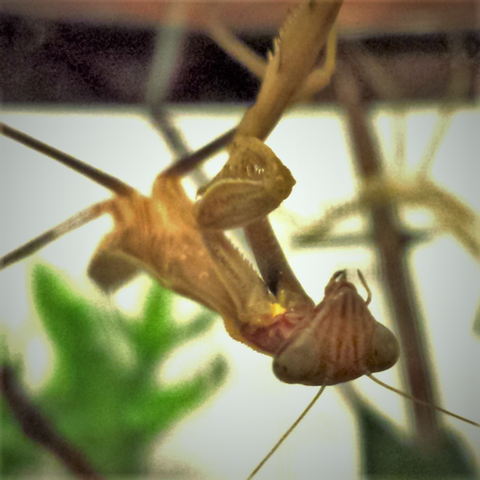Chinese Mantis Caresheet
 Housing
Housing
The Chinese Mantis (Tenodera sinensis) should be kept in an enclosure that is at least 3 times as tall as the mantis is long, and at least 2 times as wide as the mantis is long. Chinese mantises are some of the largest of the mantis species that are kept as pets, so this is a very important thing to consider when deciding whether or not you would like to adopt this species. Chinese mantises can get over 4 inches long as adults. The cage must have adequate ventilation, and some kind of material on the ceiling of the enclosure which will allow the mantis to hang upside down during molting, as well as an empty space at the top which is at least 2 times the size of the mantis. Chinese mantises can be kept successfully in a living vivarium with live plants and microfauna (e.g., springtails and isopods) who will act as a sort of "clean up crew" by breaking down the mantis's waste. They can also be kept in a temporary enclosure such as a mesh cage or screen cage, with silk plants (such as an Ivy Branch, Leafy Branch, Orchid Flower, or White Flower) and an easily disposable substrate such as sphagnum moss, or even just a paper towel that you can change once a week. However, if you chose to keep them in enclosures with glass or clear plastic sides, a screen top is necessary to keep it from getting too moist inside the enclosure. This species is highly cannibalistic and should not be houses together after L2.
Temperature & Humidity
Chinese mantises can tolerate a fair range when it comes to temperature and humidity, although they prefer it on the drier side, and closer to room temperature. They should do well being kept anywhere between 70°F and 85°F. Ideally, humidity should stay in the range of 50% to 60% relative humidity (RH).
The enclosure should be given a light misting at least once a day so that your mantis can drink. When kept in mesh cages, we mist the enclosure twice a day. Most mantises do not like getting sprayed directly, so it is best to try and spray around the mantis, but if you get them a little wet by accident, it is usually no big deal. Use spring water, distilled water, or water filtered by reverse osmosis (RO), but do not use plain tap water.
Feeding
Chinese mantises can eat a variety of prey items. As adults, these mantises are good candidates for larger prey items, such as adult crickets and cockroaches.
- L1 through L3 nymphs: Should be fed D. hydei fruit flies.
- L4 and L5 nymphs: Should be fed house flies or blue bottle flies.
- L6 nymph to adult: Should be fed blue bottle flies as a staple. They can also handle some larger prey items such as cockroaches.
Before choosing to feed any of your mantises crickets, please read Is it Safe to Feed Crickets to Your Praying Mantis?
For additional information about the Chinese mantis, including breeding and ootheca care please reference the links below:
Chinese Mantis (Tenodera sinensis) Caresheet – Keeping Insects

 Housing
Housing